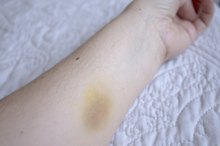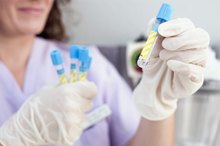Treatment for a Blown Vein
A blown vein is essentially an injury to a vein due to the insertion of an IV. This often takes place when the needle goes in too deep, puncturing the vein on both sides, Not only can this cause the vein to become unviable, but may also prompt leakage of both blood and any fluids administered through the IV. "Blowing" a vein may lead to extravasation or infiltration 1.
If you are experiencing serious medical symptoms, seek emergency treatment immediately.
Detecting the Blown Vein
The most obvious symptom of a blown vein is abnormal swelling, especially when fluids are being administered into the blood vessel. Since the fluids are seeping out of the vein, they have a tendency to pool just under the skin near the injection site. This swelling is often accompanied by discoloration or bruising to the area. The puncture created by the needle is also allowing blood to seep out, where it too pools under the skin to form a bruise.
- The most obvious symptom of a blown vein is abnormal swelling, especially when fluids are being administered into the blood vessel.
Treating the Blown Vein
What Are the Causes of Shortness of Breath After Surgery?
Learn More
For relatively minor injuries to the vein, or those caught as soon as they happen, use your hands to compress the blood vessel. It's the most effective form of treatment by far. By placing pressure on the area, you minimize blood loss and reduce inflammation. This can then be followed with an ice pack to further limit inflammation and bruising as well as ease any pain.
If a blown vein results in infiltration, which is the administration of medication into the tissue instead of the blood vessel, compression and cold therapy should still take place. However, the amount of infiltration may require further treatment, especially when a sizeable quantity of fluid has pooled under the skin. This may cause damage to the nerves, so the fluid needs to be removed (aspirated) with a needle. A follow-up surgery may be necessary to repair any damage caused to the surrounding area.
If a blown vein results in extravasation, the medication is still inadvertently administered into the tissue, but it's actually considered toxic, causing any area (other than the vein) that comes into contact with the substance to blister. Much like infiltration, the area should be compressed and aspirated. This is often followed by a saline washout, where a saline solution is injected into the area to flush the toxic chemicals. A follow-up surgery may be necessary to repair any damage caused to the surrounding area.
It may also be necessary to follow-up with a course of antibiotics, especially in cases of extravasation. Since tissue damage has most likely occurred, antibiotics can help to ensure no infection sets in.
- For relatively minor injuries to the vein, or those caught as soon as they happen, use your hands to compress the blood vessel.
- If a blown vein results in extravasation, the medication is still inadvertently administered into the tissue, but It's actually considered toxic, causing any area (other than the vein) that comes into contact with the substance to blister.
Related Articles
References
Writer Bio
Based in Minneapolis, Minn., Dana Severson has been writing marketing materials for small-to-mid-sized businesses since 2005. Prior to this, Severson worked as a manager of business development for a marketing company, developing targeted marketing campaigns for Big G, Betty Crocker and Pillsbury, among others.








